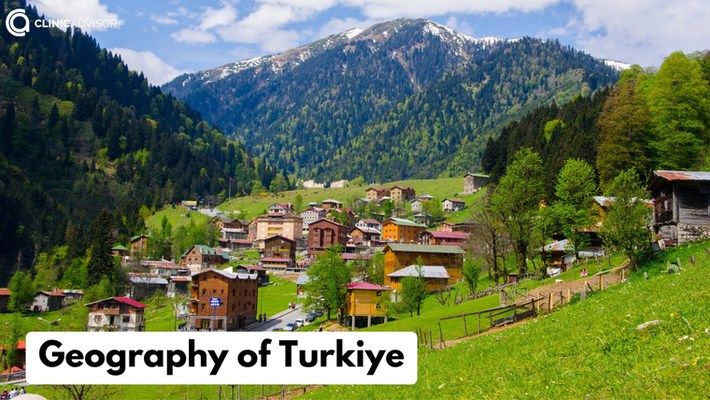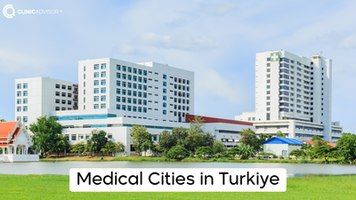The geography of Turkiye is very diverse due to its strategic location between the continents of Asia and Europe. Turkiye is located at the crossroads of Europe and Asia. While the interior and eastern parts of Turkiye are characterized by high plateaus and rugged mountains, the coastal areas are characterized by narrow coastal plains.
Turkiye is rich in a variety of natural resources and is blessed with ideal land for agriculture, with approximately 15.2% of the land arable. About 15% of Turkiye is covered by forests. The largest city in terms of population density, which is also an economic center, is Istanbul, although the capital is Ankara.
Where is Turkiye located on the map?
Turkiye is located at the crossroads between the continents of Asia and Europe on the map, and the majority of its territory is located in the Anatolian Peninsula in Asia. The northern coast of Turkiye is bordered by the Black Sea while the western coast is bordered by the Aegean Sea. Its unique location extends to both Europe and Asia, where the Bosphorus Strait represents the link between them.
What time does the sun rise in Turkiye?
In Turkiye, the sun usually rises around 5:30 a.m. and sometimes at 7 a.m. depending on the seasons. Turkiye's location in Eastern Europe means that it receives sunlight earlier than Western countries. Turkiye is located at latitude 39°55' north and longitude 32°50' east.
What time does the sun set in Turkiye?
In Turkiye, the sun usually sets around 7:30 pm or 8:30 pm depending on the seasons.
What is Turkiye's geographical location?
The geographical coordinates of Turkiye are 39° 55' north latitude and 32° 50' east longitude.
Is there a sea in Turkiye?
Turkiye is surrounded by seas on three sides: the Black Sea to the north, the Aegean Sea to the west, and the Mediterranean Sea to the south, its combined coastline is about 8,333 km
What is the area of Turkiye?
Turkiye has an area of 783,356 square kilometers. The central parts of Turkiye are characterized by high plateaus, while the coastal areas are characterized by narrow coastal plains. About 15.2% of Turkiye's land is used for agriculture. Turkiye is also home to vast forests that cover about 15% of the land.
What are Turkiye's neighboring countries?
Tirkiye has a variety of neighboring countries. Such as Greece and Bulgaria to the northwest; and Georgia in the northeast; Armenia, Azerbaijan, and Iran to the east; And Iraq and Syria to the south. The Aegean Sea and the Mediterranean Sea lie to the west, providing maritime borders with Greece and Cyprus.
What are the geographical regions of Turkiye?
Turkiye is divided into seven geographical regions, and each region has unique geographical characteristics:
- Aegean Sea region.
- Black Sea region.
- Central Anatolia region.
- Eastern Anatolia region.
- Marmara Region.
- Mediterranean region.
- Southeastern Anatolia region.
How many cities are there in Turkiye?
Turkiye is divided into 81 provinces, each of which is also considered a city.
What are the main cities in Turkiye?
Some of the major cities in Turkiye include Istanbul, Ankara, Izmir, Bursa, Antalya, and Adana. Each city boasts its own unique culture, history, and geographic features.
What are the coastal cities in Turkiye?
Coastal cities in Turkiye include Istanbul, Izmir, Antalya, Trabzon, Mersin, and others. These cities are known for their beautiful coastlines and are popular tourist destinations.
How long is the Turkish continental shelf?
The length of Turkiye's continental shelf varies along its extensive coast and is subject to international maritime law and ongoing negotiations with its neighbors.
What is the physical map of Turkiye?
The physical map of Turkiye has its own diverse features, such as rugged mountain ranges, a high central plateau, and narrow coastal plains, as well as the seas surrounding the country and its largest bodies of water, such as Lake Van and Lake Tuz.
What are the characteristics of mountains in Turkiye?
Turkiye is home to several mountain ranges, including the Taurus Mountains in the south, the Pontic Mountains in the north, and the rugged Eastern Anatolia region, which includes Mount Ararat, Turkiye's highest peak.
What plains are there in Turkiye?
There are several plains in Turkiye, including the Konya Plain in central Anatolia, which is one of the largest plains in the country, and the Cukurova Plain in the south, known for its agricultural productivity.
What rivers are there in Turkiye?
Turkiye is traversed by many rivers, including the Kizilrmak River, which is the longest river entirely within Turkiye. The Sakarya and Yesilirmak Rivers are in the north, and the Tigris and Euphrates Rivers, have their sources in eastern Anatolia.
What types of soil are there in Turkiye?
Turkiye has a variety of soil types due to its diverse climates and geographical characteristics. They range from fertile alluvial soils in the coastal plains and river valleys to drier, less fertile soils in the central plateau and mountainous regions.
Does Turkiye Lie in an earthquake zone?
Yes, Turkiye is one of the most seismically active countries in the world because it lies on several active tectonic plates, the most notable of which is the North Anatolia Fault.
What minerals are found in Turkiye?
Turkiye is rich in mineral resources, including coal, iron ore, copper, gold, silver, zinc, lead, and chromium. It also has large deposits of boron, of which Turkiye is the world's largest producer.
What are the natural beauties of Turkiye?
Turkiye is famous for its natural beauty, from the unique rock formations and underground cities of Cappadocia, the limestone terraces of Pamukkale, the mountainous Black Sea region, the Mediterranean and Aegean coasts, to the peaks of Mount Ararat.
How does Turkiye's geography affect its climate?
Turkiye's diverse geography results in a diverse climate throughout the country. The coastal areas along the Aegean Sea and the Mediterranean Sea have a Mediterranean climate with hot, dry summers and mild, humid winters.
In contrast, the Black Sea region has a temperate oceanic climate with warm, humid summers and cold, wet winters. The interior of the country, particularly the Central Anatolian Plateau, experiences a more extreme continental climate with hot summers and cold winters, with large temperature differences between day and night.
How does Turkiye's geography affect its culture?
Turkiye's geographical location, at the crossroads of Europe and Asia, has resulted in a rich and diverse cultural heritage. Influences from the many civilizations that inhabited the region, including the Greeks, Romans, Byzantines, and Ottomans, can be seen in the country's architecture, cuisine, music, and traditions.
In addition, the diverse landscapes and climates across the country shaped local cultures, influencing agricultural practices, types of crops grown, and regional culinary specialties. The country's coastal regions, for example, have strong seafaring traditions and cooking based heavily on seafood, while the interior has more nomadic and pastoral traditions, with a diet based on meat and dairy products.








